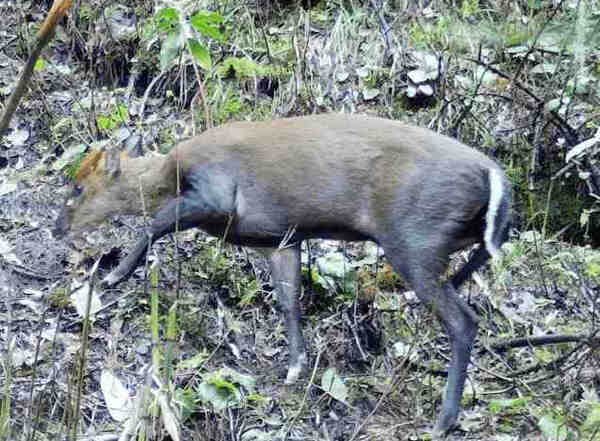Muntiacus gongshanensis
IUCN
LCBasic Information
Scientific classification
- name:Muntiacus gongshanensis
- Scientific Name:Muntiacus gongshanensis,Gongshan Muntjac,Muntjac, Green Muntjac, Black Muntjac
- Outline:Ungulata
- Family:Artiodactyls Ruminantia Cervidae Muntiacinae Muntjac
Vital signs
- length:95-104.5cm
- Weight:16-24kg
- lifetime:9years
Feature
The hoof is the most developed among muntjacs.
Distribution and Habitat
Distributed in China and northeastern Myanmar (west slope of Gaoligong Mountain).
Uncertain existence: Bhutan, India.
In China, it is distributed in Gongshan, Fushan, Lushui and Tengchong of Gaoligong Mountain in northwest Yunnan, and Bomi in southeastern Tibet.
Gongshan muntjac mainly inhabits mid-alpine broad-leaved forests, mixed coniferous and broad-leaved forests and alpine moist dark coniferous forests at an altitude of 2,000 meters.
Appearance
Gongshan muntjac is a medium-sized muntjac. The weight is 16-24 kg, the body length is 950-1045 mm, the tail length is 88-162 mm, and the total skull length is 195-205 mm. No tuft of hair on forehead. The frontal glands are unremarkable. The chin is small. The male's horns are the shortest in the genus. The horn stalk is thin and short, covered with brown-yellow bristles; the horn stem is pointed and rounded, with few longitudinal grooves. The eyebrow branches are long and thick. The shank is shorter than the stem. The horn handle is about 30 mm long and 13.5 mm in diameter; the horn is about 70 mm long, which is significantly thicker than that of Filipina's muntjac.
The body hair is long and thick. The back color of the body is dark brown, which is an intermediate type between medium dark and light colors in the muntjac genus. The body abdomen, including the throat and under the neck, is dark sandy gray. The sides and limbs of the body are dark, and the tail hairs are lon
Details
Gongshan Muntjac has no subspecies and belongs to the medium-sized muntjac.

Gongshan Muntjac generally moves alone at night, is more active in the early morning and dusk, and is less active during the day. They like to eat green grass on the grass slopes at the edge of the forest, and also eat fresh branches and leaves in the sparse forest. They mainly feed on fresh leaves, branches and herbs of evergreen broad-leaved trees. They like water, can swim, and move freely across streams. Gongshan muntjacs usually give birth from May to July, with a gestation period of 5-6 months, one litter per year, and 3-5 cubs per litter.
Although the Gongshan muntjac is dark in color, only its limbs, tail and abdomen are pure black, while its head, neck and trunk are dark brown. The color contrast between its body and legs is clear, which is also the feature that distinguishes them from black muntjacs. The main difference between Gongshan muntjacs and the red muntjacs distributed in the same area is the tail. Although the red muntjac can be very brown and its legs can be very black, the tail of the red muntjac is always the same color as the trunk, while the outer side of the tail and the buttocks of the Gongshan muntjac are always pure black, which is very obvious in color contrast with the rest of the trunk.
Gongshan muntjac is rare in Gaoligong Mountain area. In the past, it was often mistaken for Philippine muntjac. These two muntjacs account for less than 10% of the total number of muntjac skins purchased in Gaoligong Mountain area, only dozens of pieces per year. When it was named as a new species, it may have become an endangered animal. It has attracted the attention of international nature conservation organizations (Wang Yingxiang, 1998). According to the survey from 2001 to 2006, Gongshan muntjac is still being hunted in its distribution area in Tibet and Yunnan, China. The distribution area is shrinking, the habitat is destroyed, and the population is scarce. The protected areas that have been established in China include Yunnan Nujiang Nature Reserve, Yunnan Gaoligong Mountain Nature Reserve, Tibet Bomigang Nature Reserve, Tibet Zayu Nature Reserve and Medog Nature Reserve. Although protected areas have been established in the habitat, they are often hunted because they are often mistaken for ordinary muntjacs and are not protected.
Listed in the IUCN Red List of Threatened Species in 2015 ver 3.1 - Data Deficient (DD).
Listed in the China Species Red List - Endangered (EN).
Listed in the China Biodiversity Red List (Mammals) - Critically Endangered (CR).
Listed in the China Endangered Wildlife List - Endangered (EN).
Listed in the second level of the China National Key Protected Wildlife List.
Protect wild animals and stop eating game.
Maintaining ecological balance is everyone's responsibility!








